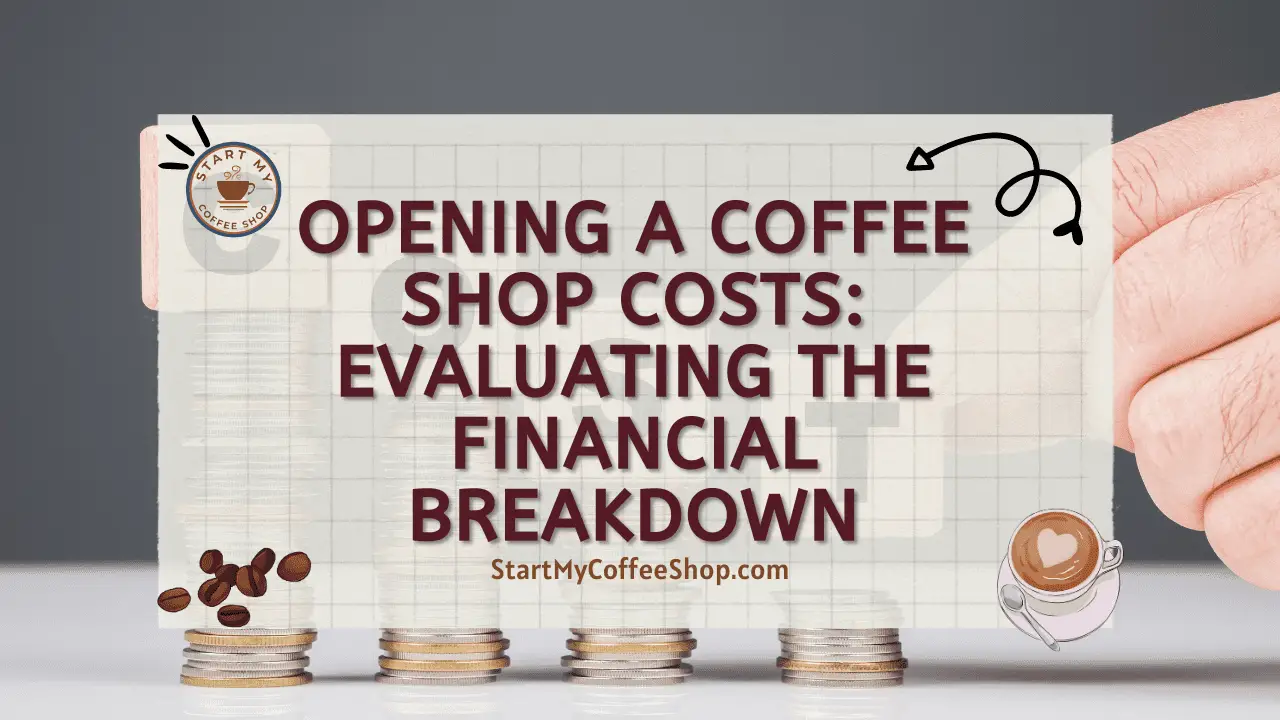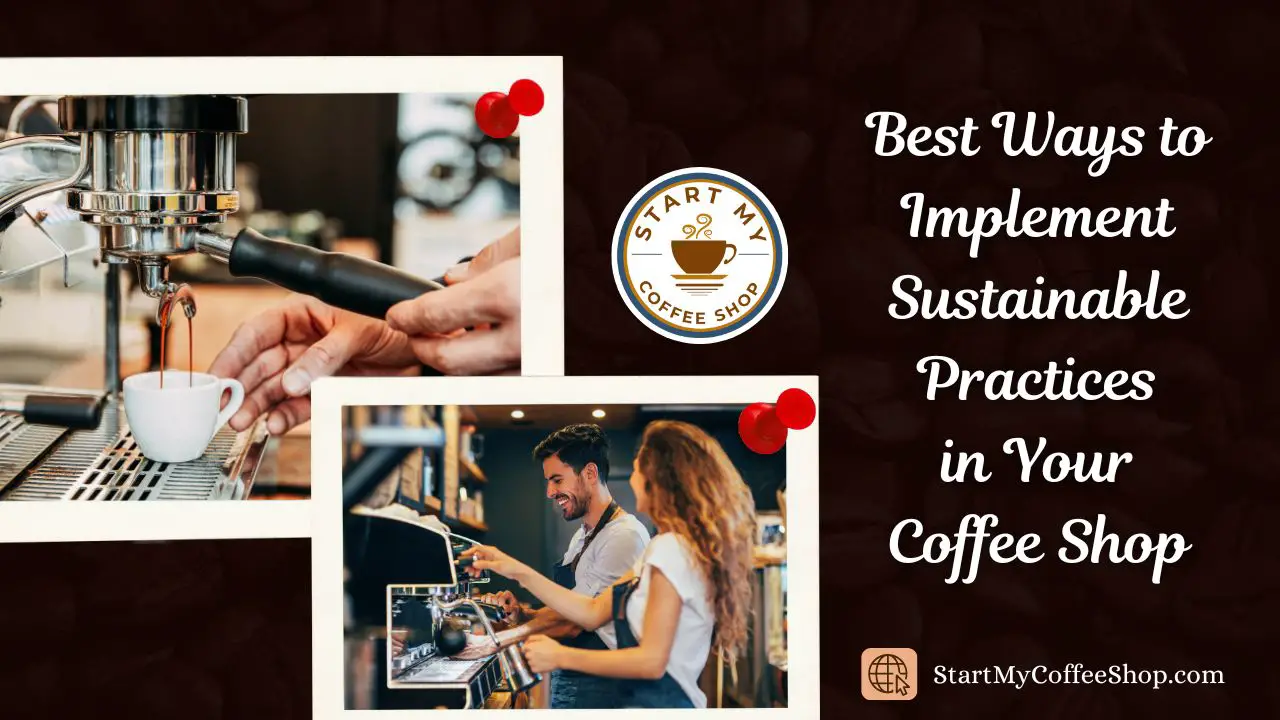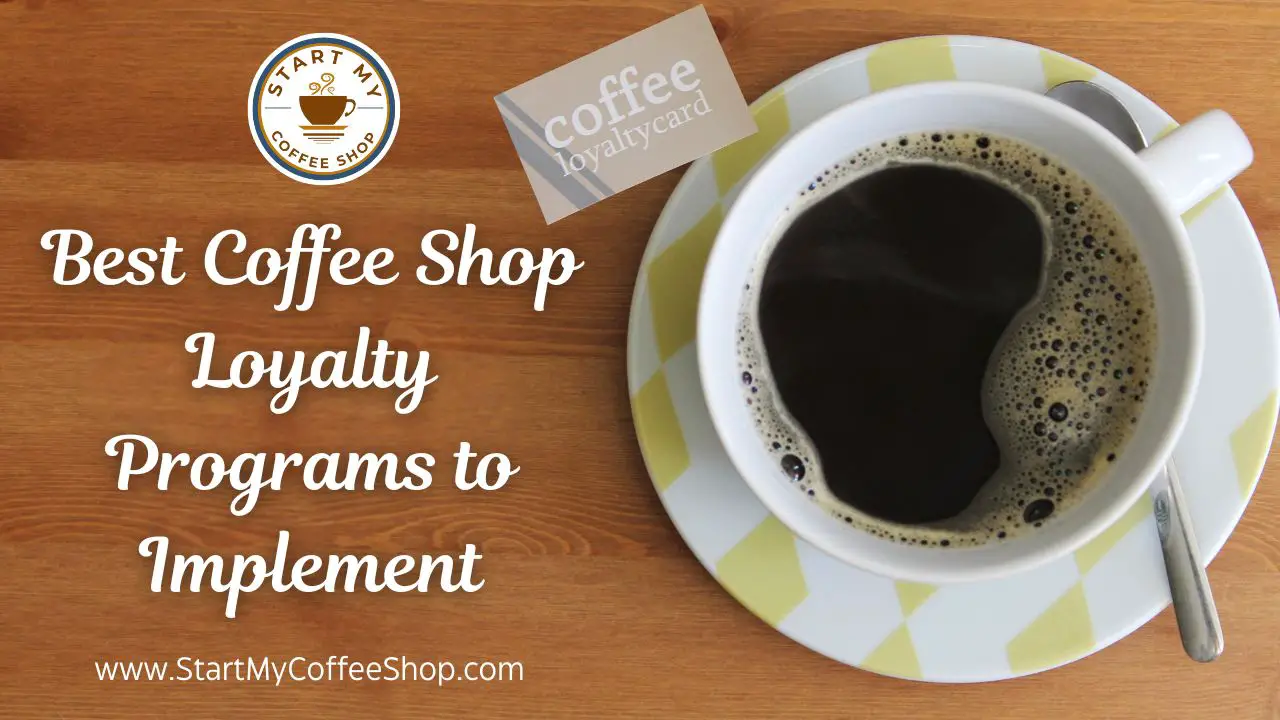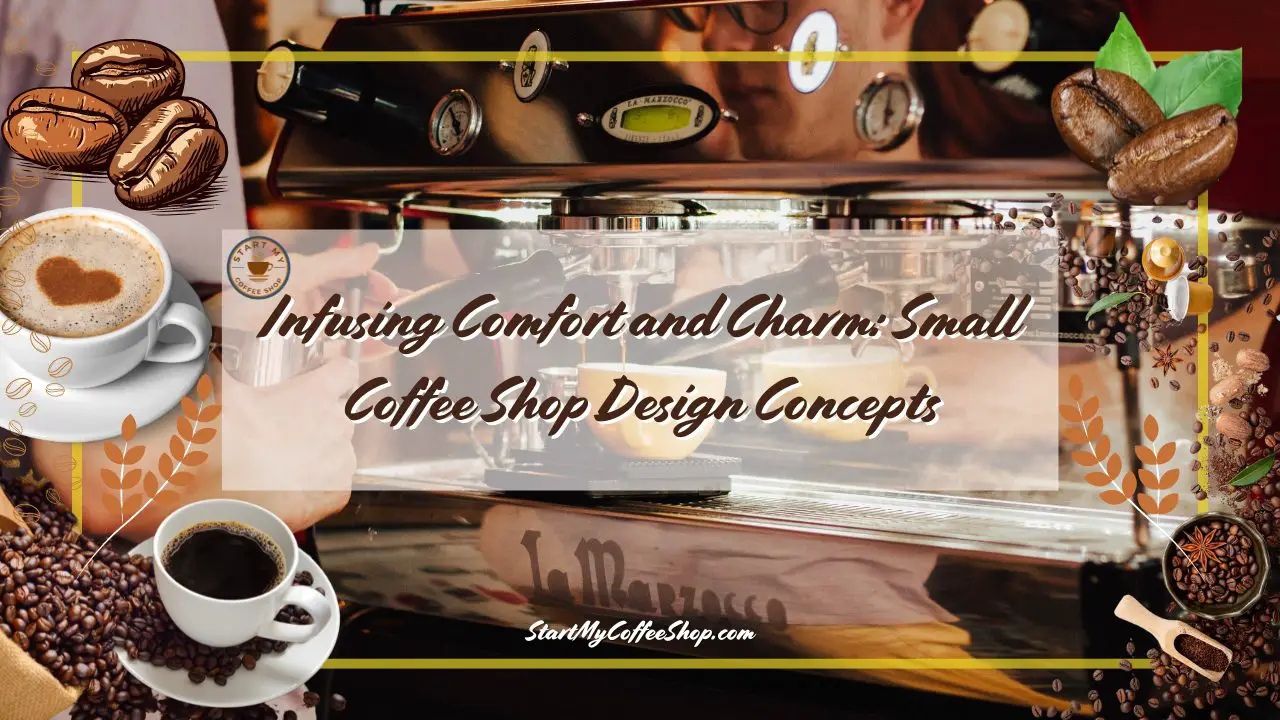Opening a coffee shop is a dream for many aspiring entrepreneurs, but it requires careful planning and financial consideration.
The cost to open a coffee shop, including equipment, furnishings, permits, and initial inventory, varies widely. On average, it can range from $80,000 to $300,000 or more, depending on factors such as location, size, and specific requirements.
In this article, I will explore the various costs involved in opening a coffee shop, covering everything from equipment and furnishings to permits and initial inventory.
Location and Lease Expenses
 Choosing the perfect location for your coffee shop is a critical decision that can have a significant impact on your costs and overall success. The location sets the stage for attracting customers, building a loyal clientele, and maximizing your business potential.
Choosing the perfect location for your coffee shop is a critical decision that can have a significant impact on your costs and overall success. The location sets the stage for attracting customers, building a loyal clientele, and maximizing your business potential.
Here are some key considerations and costs associated with selecting the right spot for your coffee shop:
Foot Traffic and Accessibility
One crucial factor to evaluate when choosing a location is foot traffic. High foot traffic areas, such as downtown districts, shopping centers, or near popular attractions, can provide excellent visibility and potential customers passing by. However, these prime locations often come with higher lease prices due to the increased demand. On the other hand, less central locations might offer more affordable lease options, but it’s important to assess the potential impact on customer reach and convenience.
Nearby Competition
Analyzing the competition in the vicinity is essential. Is there a cluster of coffee shops in the area or are you among a limited number? A high concentration of coffee shops may indicate a strong demand for coffee in that area, but it also means facing stiffer competition. In contrast, being the only coffee shop in a specific neighborhood might give you an advantage. Consider your unique selling points and how you can differentiate yourself from competitors.
Lease Expenses
Lease prices can vary significantly depending on the location, size, and market demand. Prime locations often command higher lease rates due to their visibility and access to customers. Be prepared to allocate a significant portion of your budget for lease expenses. It’s essential to negotiate favorable terms and understand the lease agreement thoroughly. Upfront costs associated with leasing include security deposits, rent advances (first and last month’s rent), and legal fees if you seek professional assistance in reviewing or drafting the lease agreement.
Renovations and Build-Out Costs
When selecting a location, consider the state of the space and whether any renovations or build-outs are required. Costs associated with remodeling, interior design, and ensuring compliance with health and safety regulations can add up. Depending on the condition of the space and your desired aesthetic, you may need to budget for paint, flooring, plumbing, electrical work, and other modifications.
Marketing and Signage
Once you’ve secured a location, you’ll want to promote your coffee shop effectively. Allocating a portion of your budget for marketing and signage is crucial. Costs may include designing and printing menus, signage, banners, and other promotional materials. Additionally, investing in online marketing channels, such as website development, social media advertising, and local promotions, can help create awareness and attract customers to your coffee shop.
Read more about Cost to Start Coffee Shop Business: The Unfiltered Finances
Equipment and Furnishings
Equipping your coffee shop with the necessary tools and furnishings is a crucial aspect that requires careful consideration and financial planning. The cost of equipment can vary widely based on factors such as quality, brand, and specific requirements.
Here are some key equipment and furnishings to consider, along with the associated expenses:
Espresso Machines
One of the most vital investments for a coffee shop is a quality espresso machine. These machines range in price depending on their features, size, and brand. Entry-level machines can cost around $2,000, while more advanced and commercial-grade options can exceed $10,000. It’s important to assess your specific needs, considering factors like the volume of coffee you anticipate serving and the level of control you require over the brewing process.
Coffee Grinders
To achieve the best flavor and quality, investing in a high-quality coffee grinder is essential. The cost of coffee grinders can vary depending on their capacity, grind consistency, and durability. Home-grade grinders can start at around $100, while commercial-grade ones can range from $500 to several thousand dollars. Consider the volume of coffee you plan to grind daily and choose a grinder that meets your business requirements.
Blenders and Refrigerators
If you plan to offer blended beverages or serve chilled items like iced coffees or smoothies, you’ll need reliable blenders and refrigerators. Blenders suitable for commercial use can cost between $200 and $600, while commercial-grade refrigerators can range from $1,000 to $5,000, depending on their size, features, and energy efficiency.
Display Cases
Presenting your pastries, sandwiches, and other food items in attractive display cases enhances the visual appeal of your coffee shop. Display cases can range from countertop models to larger refrigerated or non-refrigerated cases. Costs can vary from a few hundred dollars to several thousand, depending on the size, style, and features you choose.
Seating, Tables, Lighting, and Decor
Creating a comfortable and inviting ambiance is crucial for attracting and retaining customers. Investing in comfortable seating, sturdy tables, proper lighting, and appealing decor elements is essential. The costs for furnishings can vary depending on your desired style, quality, and quantity. Consider factors such as the size of your space, the number of seats you want to provide, and the overall theme or aesthetic you wish to achieve.
It’s important to strike a balance between quality and budget when purchasing equipment and furnishings for your coffee shop. Research different suppliers, compare prices, and read customer reviews to ensure you’re making informed decisions.
Remember that investing in durable, reliable equipment and creating an inviting atmosphere through well-chosen furnishings can contribute to a positive customer experience and the long-term success of your coffee shop.
Licenses, Permits, and Legal Requirements
 Complying with local regulations and obtaining the necessary licenses and permits is an essential aspects of opening and operating a coffee shop. Failure to adhere to these requirements can result in fines, penalties, or even closure of your business.
Complying with local regulations and obtaining the necessary licenses and permits is an essential aspects of opening and operating a coffee shop. Failure to adhere to these requirements can result in fines, penalties, or even closure of your business.
Here are some key permits and licenses to consider, along with potential costs:
Business License
Obtaining a business license is typically the first step in establishing your coffee shop. The cost of a business license can vary depending on your location and the type of entity you operate (sole proprietorship, partnership, corporation). Fees may range from a few hundred dollars to several thousand dollars, and they may be renewable annually or on a different schedule determined by local regulations.
Health Permits
Health permits are necessary to ensure that your coffee shop meets specific health and safety standards. These permits are typically issued by local health departments or agencies. The fees for health permits vary by jurisdiction and can range from $100 to $500 or more per year. Inspections may also be required to ensure compliance with regulations regarding food preparation, storage, cleanliness, and employee hygiene.
Food Handling Permits
If your coffee shop serves food, you may need additional permits specifically for food handling. These permits demonstrate that you and your staff have received proper training in food safety and handling practices. The costs and requirements for food handling permits can vary depending on the jurisdiction. Some areas may require specific certifications, which might involve fees for training programs or exams.
Zoning Permits
Zoning permits are essential to ensure that your coffee shop is located in an area where commercial activities, such as food service, are allowed. The cost of zoning permits can vary significantly depending on local regulations and the complexity of your application. It’s important to research zoning requirements and consults with local planning or zoning departments to understand the associated costs and processes.
Signage Permits
If you plan to install outdoor signage for your coffee shop, you may need signage permits. These permits regulate the size, placement, and design of signs to ensure compliance with local regulations. Costs for signage permits can vary depending on factors such as the size and type of signage. Some jurisdictions may charge a flat fee, while others calculate fees based on the square footage of the sign.
To avoid any surprises and unnecessary delays, it’s crucial to thoroughly research and understand the specific licensing and permit requirements in your area. Contact local government offices, such as city or county clerk offices, health departments, and zoning departments, to obtain accurate information about the necessary permits and associated costs.
4. Initial Inventory and Supplies
Stocking up on the necessary supplies is a vital step when opening a coffee shop. It’s crucial to carefully consider the inventory requirements based on the size of your shop, the menu offerings you plan to provide, and your projected customer demand.
Here are some key aspects to consider when budgeting for your initial inventory costs:
Coffee Beans
As the heart of your business, investing in high-quality coffee beans is essential. The cost of coffee beans can vary depending on factors such as the origin, quality, and brand. Specialty or single-origin beans typically come at a higher price than blends. Consider the estimated consumption and preferences of your target customers when determining the quantity of beans needed.
Syrups and Flavorings
To offer a variety of flavors in your coffee beverages, you’ll need to stock up on syrups and flavorings. These can include popular options like vanilla, caramel, hazelnut, and seasonal variations. The cost of syrups and flavorings depends on the brand, size, and quantity purchased. Consider starting with a basic selection and expanding as you gauge customer preferences.
Milk and Dairy Alternatives
If your menu includes milk-based drinks, you’ll need to budget for milk and dairy alternatives such as almond, soy, or oat milk. The cost of milk depends on the type and quantity you purchase. Consider the volume of milk-based beverages you anticipate serving and the shelf life of the milk to minimize waste.
Pastries and Baked Goods
If you plan to offer pastries and baked goods, factor in the cost of sourcing or producing these items. You can choose to collaborate with local bakeries or invest in in-house production. Consider the variety and quantity of pastries you want to offer and negotiate prices with suppliers or calculate production costs accordingly.
Other Supplies
In addition to the core ingredients, don’t forget to budget for other essential supplies such as cups, lids, stirrers, napkins, and cleaning materials. These items contribute to the overall customer experience and operational efficiency. Consider the volume of take-out orders and in-house consumption to estimate your supply needs accurately.
Building relationships with reputable suppliers and wholesalers can help you secure competitive prices and ensure a steady supply of quality ingredients. Research and reach out to different suppliers to compare prices, negotiate terms, and establish reliable partnerships.
Staffing and Training
 Building a competent and well-trained team is vital when it comes to running a successful coffee shop. The costs associated with hiring and training staff members should be carefully considered and incorporated into your budget.
Building a competent and well-trained team is vital when it comes to running a successful coffee shop. The costs associated with hiring and training staff members should be carefully considered and incorporated into your budget.
Here are some key aspects to consider when planning for staffing costs:
Employee Wages and Benefits
One of the significant costs of staffing is employee wages. The specific wage rates will depend on factors such as your location, local labor laws, and the experience level of your staff. Take into account the number of employees you’ll need to adequately operate your coffee shop, including baristas, servers, and possibly a manager. Additionally, consider benefits such as healthcare, paid time off, and any other benefits you plan to offer to attract and retain quality employees.
Training Programs
Investing in training programs for your staff is crucial to ensure consistent and high-quality coffee preparation and customer service. Training costs may include initial training for new hires and ongoing training to keep your team up to date with new techniques, menu offerings, and customer service standards. You can choose to provide in-house training or outsource to professional training providers. Consider allocating a portion of your budget for training materials, resources, and potential fees associated with external training programs.
Recruiting and Hiring Expenses
Recruiting and hiring costs may include advertising job openings, conducting interviews, and conducting background checks. These expenses can vary depending on the extent of your recruitment efforts and the methods you use to attract potential candidates. Consider utilizing online job platforms, local job fairs, or partnering with employment agencies to find qualified candidates.
Employee Retention Strategies
Retaining skilled and dedicated staff members is essential for the long-term success of your coffee shop. Consider implementing employee retention strategies such as performance-based incentives, recognition programs, and opportunities for growth and advancement within your establishment. These strategies can help reduce turnover and the associated costs of constantly recruiting and training new staff.
Read more about Cost to Start Drive-Thru Coffee Shop: A Cupful of Expenses
Marketing and Branding
 Effectively promoting your coffee shop is a crucial element in attracting customers and establishing a strong presence in the market. Allocating a portion of your budget to marketing initiatives can help create awareness, generate buzz, and ultimately drive foot traffic to your establishment.
Effectively promoting your coffee shop is a crucial element in attracting customers and establishing a strong presence in the market. Allocating a portion of your budget to marketing initiatives can help create awareness, generate buzz, and ultimately drive foot traffic to your establishment.
Here are some key aspects to consider when budgeting for your marketing expenses:
Website Development
In today’s digital age, having a professional and user-friendly website is essential. The cost of website development can vary depending on the complexity of the site, the number of pages, and the features you require. Consider investing in a visually appealing website that showcases your coffee offerings, highlights your unique selling points, and provides information about your location, hours, and contact details.
Social Media Advertising
Social media platforms are powerful tools for reaching and engaging with your target audience. Consider allocating a budget for social media advertising campaigns on platforms such as Facebook, Instagram, or Twitter. Targeted ads can help you reach a specific demographic, increase brand visibility, and drive traffic to your coffee shop.
Print Materials and Signage
Investing in well-designed print materials such as business cards, flyers, and brochures can help you reach local audiences and create a lasting impression. Additionally, outdoor signage and storefront displays play a significant role in attracting potential customers passing by. Budget for the design, printing, and installation of these materials to effectively communicate your brand and offerings to the public.
Local Promotions and Events
Consider organizing or participating in local promotions and events to increase your visibility in the community. This could involve partnering with nearby businesses, sponsoring community events, or hosting special coffee tastings or workshops. Budgeting for these initiatives allows you to actively engage with your target market and build relationships with potential customers.
Brand Identity
Building a strong brand identity is key to differentiating your coffee shop from competitors. This includes elements such as logo design, packaging, and uniform design. Investing in professional branding services can help create a cohesive and visually appealing brand identity that resonates with your target audience. Budgeting for these branding elements ensures consistency across all touchpoints and enhances your overall marketing efforts.
Utilities, Rent, and Insurance
Running a coffee shop involves more than just the initial costs; there are also recurring expenses that need to be considered. These ongoing expenses should be factored into your budget to ensure the smooth operation of your business.
Here are some key recurring expenses to keep in mind:
Utility Bills
Monthly utility bills, such as electricity, water, internet, and phone services, are essential for the day-to-day functioning of your coffee shop. These expenses can vary depending on factors like the size of your space, equipment usage, and your location. It’s important to estimate and allocate a portion of your budget for these recurring bills.
Insurance Coverage
Protecting your coffee shop from potential risks is crucial. Obtaining insurance coverage, such as general liability insurance, property insurance, and workers’ compensation insurance, is essential to safeguard your business against unexpected events. The cost of insurance premiums can vary depending on factors like the size of your business, location, and coverage limits. Consulting with an insurance agent can help you determine the appropriate coverage and associated costs.
Rent
If your lease agreement doesn’t include rent expenses, it’s important to consider this ongoing cost. Monthly rent can vary depending on factors like location, size of the space, and market rates. Ensure that you have a clear understanding of your rent obligations and include it in your monthly budget.
Maintenance and Repairs
Regular maintenance and occasional repairs are part of the ongoing expenses of running a coffee shop. This includes routine maintenance of equipment, plumbing, and electrical systems, as well as repairs or replacements when necessary. It’s advisable to set aside a portion of your budget for these expenses to ensure that your coffee shop remains in good working order.
Summary
Opening a coffee shop requires careful financial planning and a clear understanding of the various costs involved. By considering location expenses, equipment, and furnishings, licenses and permits, inventory and supplies, staffing and training, marketing and branding, as well as utilities and insurance, you’ll be better prepared to manage your finances and set realistic expectations. Remember, with the right combination of passion, diligence, and a well-thought-out budget, you can turn your coffee shop dream into a thriving reality.
Frequently Asked Questions
Q: How do I choose the right location for my coffee shop?
A: A prime location in a busy area may come with higher lease prices, while a less central location might be more affordable. Evaluating these factors can help you find a location that aligns with your target market and budget.
Q: What permits and licenses are required to open a coffee shop?
A: The specific permits and licenses needed vary by location, but typically include health permits, food handling permits, zoning permits, and signage permits.
Q: How much does it cost to equip a coffee shop with the necessary tools and furnishings?
A: The cost of equipment and furnishings for a coffee shop can vary based on your desired quality, brand preferences, and the size of your establishment.
To learn more on how to start your own coffee shop checkout my startup documents here
Please note: This blog post is for educational purposes only and does not constitute legal advice. Please consult a legal expert to address your specific needs.

Hi! I’m Shawn Chun
My adventure in coffee began when I first launched my first coffee shop back in the early 2000s. I had to figure out so many things on my own and to make it worse within 2 years of opening two large corporate coffee chains moved in just blocks away from me!
As I saw smaller and even some larger coffee shops in the neighborhood slowly lose customers to these giant coffee chains and slowly close up shop, I knew that I had to start getting creative…or go out of business.
I (like you may be) knew the coffee industry well. I could make the best latte art around and the foam on my caps was the fluffiest you have ever seen. I even had the best state-of-the-art 2 group digital Nuova Simonelli machine money could buy. But I knew that these things alone would not be enough to lure customers away from the name brand established coffee shops.
Eventually, through lots of trial and error as well as perseverance and creativity I did find a way to not only survive but also thrive in the coffee/espresso industry even while those corporate coffee chains stayed put. During those years I learned to adapt and always faced new challenges. It was not always easy, however, in the end, I was the sole survivor independent coffee shop within a 10-mile radius of my location. Just two corporate coffee chains and I were left after that year. All told the corporate coffee chains took down over 15 small independent coffee shops and kiosks and I was the last one standing and thriving.
Along the years I meet others with the same passion for coffee and I quickly learned that it is not only “how good a barista is” that makes a coffee shop successful, but the business side of coffee as well.
Hence why I started this website you are on now. To provide the tools and resources for up and coming coffee shop owners to gain that vital insight and knowledge on how to start a coffee shop successfully.
Stick around, browse through my helpful blog and resources and enjoy your stay! With lots of LATTE LOVE!
Shawn






